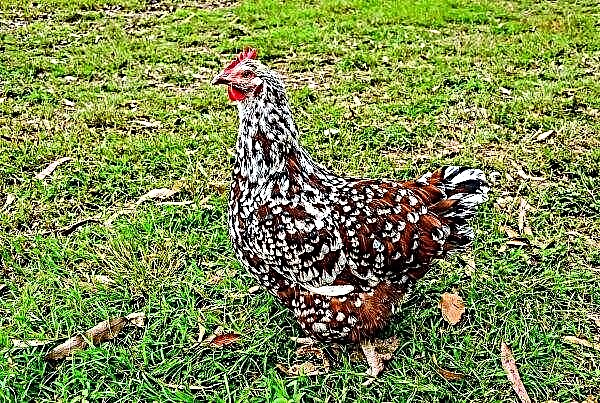"Dilabic" - a drug aimed at combating Varroa ticks (varroatosis). To make its use as safe and productive as possible, you must carefully read the instructions for use. In this article, you will learn about the rules that must be followed so that processing the hives yields the desired result and does not harm the health of the bees.
Did you know? In the year 2000 «Dilabic» was named "Best Product of the Year."
Composition and form of release
The drug is produced in ampoule form. Each ampoule contains 0.5 ml, or 1 ml of solution for external use. Each package contains 10 ampoules. The active ingredients in the composition are represented by a mixture of two varieties of amitrase, the highest degree of purification. Excipients: emulsifier neonol AF-10 and solvent - o-xylene.

Properties and principle of operation
The main feature of Dilabic is its composition, which uses a synergistic mixture of the substance, which allows the medication to introduce a minimum amount of toxic substances into the hive, but at the same time be effective in combating ticks.
The synergistic mixture has a unique effect on the body of ticks - they cannot develop immunity to this drug if applied periodically. It is the exclusion of the possibility of developing immunity in ticks of the substances that make up this drug, making Dilabic the most effective in the treatment of varroatosis. However, it is important to understand that to achieve the best result, just one treatment is not enough.
Indications for use
The main indication for the use of "Dilabika" is the presence of varroatosis in bees. Varroatosis or tick damage Varroa is one of the greatest health risks for bees, which is quite difficult to cope with.
This pest is known for its ability to suck hemolymph from bees, which leads to a weakening of immunity, a greater susceptibility to diseases and infections. The parasite itself can cause the spread of infectious and viral diseases.

To determine whether bees have this disease, it is necessary to periodically conduct an examination. An undetermined varroatosis in time leads to death, and not one individual can die, but the entire bee family.
The main symptom of the disease is the presence of dark brown spots or plaques on the bee’s cephalothorax. Their diameter is about 1-2 mm, and the plaques themselves are Varroa ticks. At the same time, they can affect both adults and pupae.

The presence of spots is the main indication for the use of "Dilabika" for the treatment of the bee family. Secondary symptoms of the appearance of ticks are weakness and passivity of bees, deformation of the body of the insect, poorly developed wings in adults and young individuals.
A decrease in the amount of honey and a halt in the reproduction of bees can also indicate the appearance of a parasite. However, the use of the drug solely on the basis of superficial symptoms, without a thorough examination of bees and laboratory tests, is strictly prohibited.
Did you know? Varroa ticks are characterized by a rapid change of generations, and this leads to the fact that pests quickly adapt to various drugs and develop immunity to them. Accordingly, it is almost impossible to cope with them with folk remedies, and the most effective method of treatment is medication.
Terms of use
An important factor that will determine the success of treatment is the period of its implementation. The most effective is the treatment carried out in late autumn. In the spring, bees should be treated in case of emergency.
In the autumn months, treatment should be done twice. The first processing takes place from mid-August to early September, when the pumping of honey is completed. The second part of the treatment must be carried out in late September or early October. The ambient temperature, however, should not be lower than + 3 ° C, but also not exceed + 10 ° C, which is why it is recommended to carry out processing in the evening.
Video: Varroa Dilabic tick remedy. Processing results.
Method of application, dosage
Particular attention should be paid to the preparation of the medicinal mixture. Failure to comply with the proportions is fraught with negative consequences for bees, up to the onset of death. But the methods of application may vary, so you can choose the method that is most convenient for you.
Important! Processing is possible only with a freshly prepared solution, otherwise the drug may lose its properties and not give the expected result.
There are several ways to use Dilabika:
- Preparation of the solution. To do this, you will need 1 liter of boiled water, cooled to room temperature and 1 ampoule of the drug. It is necessary to open the ampoule directly in water. The drug mixture should be thoroughly mixed and filled into pre-prepared syringes with a volume of 10 ml³. The resulting solution must be processed each street, based on the flow rate - 10 ml of solution per one. In the spring, you can carry out preventive treatment, and then you will need only 10 ml per frame, since Dilabic has a long-lasting effect. The rules for preparing the solution remain the same.
- Fine spray. For this method you will need an aerosol dispenser. The prepared solution - 1 ampoule per 1 liter of cold boiled water - must be poured into a spray device and the frame treated on both sides, for each spending only 5 ml of the solution.
- Smoke gun. The solution for this treatment is prepared more concentrated. For 1 liter of water you will need 4 ml of the drug. Within half an hour after the preparation of the solution, it is necessary to start the processing process. One bee colony will need about 2-3 ml of the finished solution, which is fed in a thin stream of steam through the lower tray. This procedure must be carried out 2-4 times, depending on the degree of damage of bees with ticks. The interval between treatments should be one week, and in the presence of a printed brood - no more than five days. The Dilabic treatment procedure should be carried out exclusively in the evening, and the air temperature at the time of treatment should be from + 12 ° C to + 25 ° C.

Contraindications and possible side effects
According to the instructions attached to the drug, there are no contraindications. However, there are periods during which it is undesirable to use the medication. These include the period of the main honey collection that occurs in the summer.
Processing with the drug at this time can adversely affect the taste of beekeeping products, so it is advisable to postpone the treatment procedures until the fall, when the honey collection is over.
Important! Initially, only one bee family should be treated - this way you can determine how much the drug is right for you and, if necessary, choose another medication for treatment. Processing all bees at the same time is extremely undesirable.
It is also undesirable to carry out processing if the air temperature is above + 12 ° С in the spring and more than + 10 ° С in the autumn. Conducting treatment in the spring should be carried out strictly as necessary, since Dilabic has a powerful effect.
The spring months are more suitable for preventive measures in order to protect the apiary from possible tick attacks. No side effects were found after using the drug.
Storage Features and Security
To save the drug in a form suitable for future use, you must follow a few simple rules:
- First of all, you should make sure that the ampoules are in a place that is reliably protected from ultraviolet radiation. This is caused by the fact that the ampoules themselves are transparent, and sunlight can adversely affect the drug mixture.
- The second rule is to maintain optimal temperature conditions. Dilabic should be stored in a place whose temperature will be from 0 ° C to + 20 ° C.
 The shelf life of the drug is 2 years from the date of manufacture - it is indicated on the package.
The shelf life of the drug is 2 years from the date of manufacture - it is indicated on the package.
During the treatment, without fail, use a respirator and gloves to avoid possible negative effects on the human body. It is important not to smoke during the treatment of the bees, not to consume any drinks and foods with pungent odors. Immediately after the procedure, wash your hands and face thoroughly.
Important! Regardless of the choice of the storage location of the drug, make sure that children do not have access to ampoules. Dilabic should not be near food.
"Dilabic" is a drug that can cope with varroatosis, but use it with caution. Failure to comply with safety rules and dosages can adversely affect both the health of the bee farm and the body of the apiary owner. To avoid negative consequences and keep the apiary healthy, carefully study the instructions, conduct a periodic examination of bees and do not abuse the medication.












